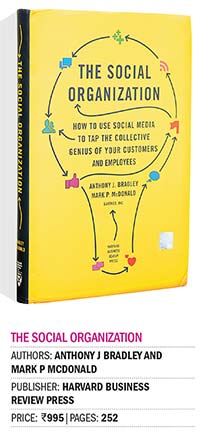
Some words seen commonly in corporate dictionaries these days did not even exist until a few years ago. Take, for example, ‘answer marketplace’. Didn’t the CEO and his enterprising teams have all the answers? Then there are other words: ‘crowdsourcing’, ‘mass collaboration’, ‘social computing’ and all the rest that have been tumbling out to create Enterprise Lexicon 2.0 to the growing bafflement of the corner cabins. Then one of these new words, ‘microblogging’, even ended up changing governments in West Asia and in North Africa. It naturally follows that social media, which has been so busy spawning these intriguing new words and concepts, suddenly becomes the subject of scores of books, each of them trying to unravel the mystery of how you can use communities that come together and create ‘tsunamis of change’. But rather than explore social media as a marketing or communication channel, the authors of The Social Organization: How to use social media to tap the collective genius of your customers and employees, Anthony J Bradley and Mark P McDonald, both from Gartner Research, look at community innovation as a tool that can be used to completely transform a company.
If you are looking for ideas, tools and a playbook on how to sell more airline seats, hotel rooms, concert tickets or cup cakes using cheap social media, this is not the book for you. If you are wondering if you can replace your customer relationship management (CRM) investment or the corporate communications department with a quick Facebook page or Twitter account, banish the thought. This is a book for business leaders who want to compress ideation cycles from years to weeks; who want to tap into the remotest corners of their company and put the ‘enterprising’ back into the enterprise; who believe their smartest idea machines are their customers and want to involve them in creating relevant businesses of tomorrow.
What can you do after you have ploughed through process maps on becoming a social organisation and management guidance tables on the principles of community collaboration? Here’s one example provided early in the book: Xilinx, a $2.4-billion semiconductor design company used social media to link 500 design engineers with customers to result in a 25% increase in productivity and customer satisfaction. In another, NASA’s Marshall Space Flight Centre is using social collaboration to build, incredible as it sounds, better rockets.
Maybe you can create your own success without relying on a book — after all, Xilinx did not read Bradley and McDonald to create its success based on techniques and approaches such as design thinking, empathy maps and game theory. But what the book does tell you is that integrating collaboration into people’s ecosystem can’t be separate from the way they normally work and play. That’s an invaluable insight.
The duality in Bradley and McDonald’s book, however, is inescapable. Mass collaboration using democratic social media cannot be modelled and controlled. Yet, the book attempts to guide the reader through purpose-built collaboration, strategy and roadmaps. The trick, then, is to judiciously ignore the corporate-speak in the book. Focus instead on the concepts that Bradley and McDonald present and brainstorm on how your business can embrace mass collaboration without looking like a clumsy wannabe.











